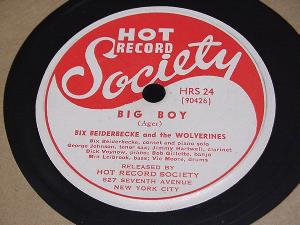Music: Hot Society
Jazz,
blowsiest of the arts, has been disgracefully lax about keeping her
barrelhouse in order. The master recordings of hundreds of notable
numbers, played by inspired but informal groups of musicians in obscure
studios, have been lost or destroyed. Copies of records made in Swing's
golden age, the 1920s, by bands like the Wolverines, Friars Society
Orchestra and New Orleans Rhythm Kings, are therefore as rare as
Gutenbergs and, to lovers ofAmerica's native
music, as valuable.
Last winter Victor repressed a series of early jazz masterpieces, sold them as the Bix Beiderbecke Memorial Album. The late great Trumpet Player Leon Bismarck ("Bix") Beiderbecke's effortless glissando, accompanied by various old bands, was to be heard sprinkling graceful, spontaneous melody through all twelve sides of the set. Two non-commercial enterprises, the Hot Club of France and the New York Hot Club, have repressed a few scarce swing classics for their members. But the commercial record companies are chiefly interested in making and selling new records, and the hot clubs are composed of amateurs uninterested in administrative detail. Wide open, therefore, was the place which a brand new Hot Record Society undertook last week to fill.
The Hot Record Society, with an office in Room 1306 at No. 303 Fifth Avenue, Manhattan, intends to issue limited editions of six famed and unavailable old recordings each year. Members are charged $6 annually, which includes the cost of the records. If the venture prospers, record dividends will be declared. Headed by Artist Stephen W. Smith and advised by a board of leading spirits from the United Hot Clubs of America, the Society seemed assured of a welcome from the nation's half-million serious jazz fanciers. "We will choose," haughtily announces the Society's first bulletin, "to reprint discs that are distinguished both by greatness of performance and by rarity, leaving the corn to the hillbillies and the more accessible hot records to the assiduousness of individual collectors."
The Society's first reissue, out this week, is Three Blind Mice played by the Chicago Loopers, a disc full of the sad harmonics and eccentric lyrical twists characteristic of the great Chicago-style. Such masters as Beiderbecke, Frankie Trumbauer (saxophone), Carl Kress (guitar), and Don Murray (clarinet) formed the band. On the two sides of the record, the masters take turns showing what they can do with variations on the common mouse theme.
